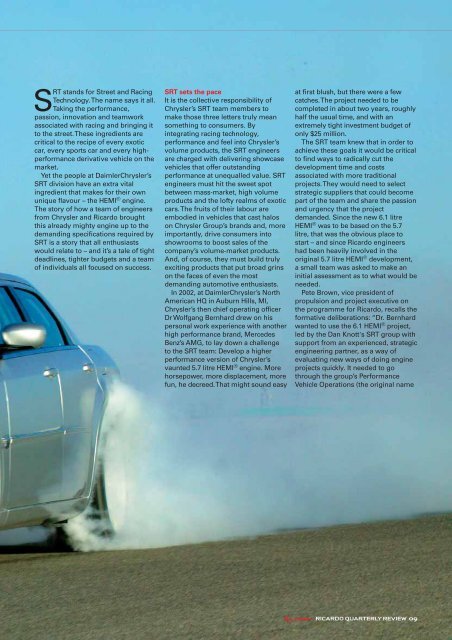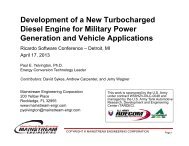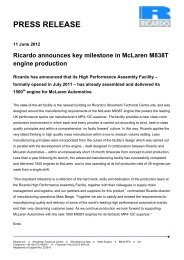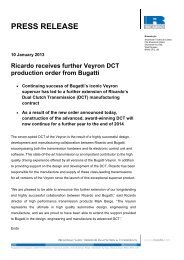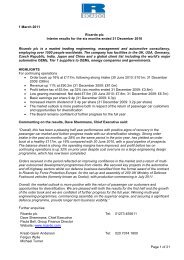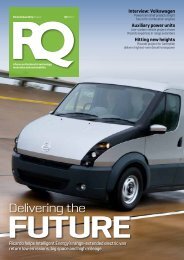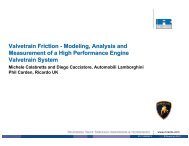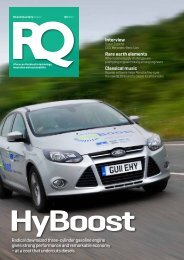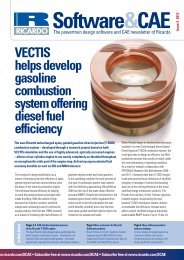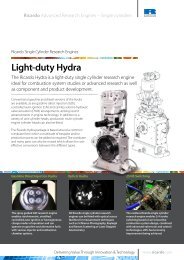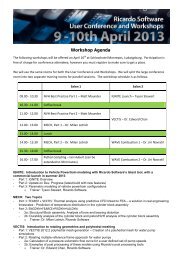The hottest - Ricardo
The hottest - Ricardo
The hottest - Ricardo
You also want an ePaper? Increase the reach of your titles
YUMPU automatically turns print PDFs into web optimized ePapers that Google loves.
SRT stands for Street and Racing<br />
Technology. <strong>The</strong> name says it all.<br />
Taking the performance,<br />
passion, innovation and teamwork<br />
associated with racing and bringing it<br />
to the street. <strong>The</strong>se ingredients are<br />
critical to the recipe of every exotic<br />
car, every sports car and every highperformance<br />
derivative vehicle on the<br />
market.<br />
Yet the people at DaimlerChrysler’s<br />
SRT division have an extra vital<br />
ingredient that makes for their own<br />
unique flavour – the HEMI ® engine.<br />
<strong>The</strong> story of how a team of engineers<br />
from Chrysler and <strong>Ricardo</strong> brought<br />
this already mighty engine up to the<br />
demanding specifications required by<br />
SRT is a story that all enthusiasts<br />
would relate to – and it’s a tale of tight<br />
deadlines, tighter budgets and a team<br />
of individuals all focused on success.<br />
SRT sets the pace<br />
It is the collective responsibility of<br />
Chrysler’s SRT team members to<br />
make those three letters truly mean<br />
something to consumers. By<br />
integrating racing technology,<br />
performance and feel into Chrysler’s<br />
volume products, the SRT engineers<br />
are charged with delivering showcase<br />
vehicles that offer outstanding<br />
performance at unequalled value. SRT<br />
engineers must hit the sweet spot<br />
between mass-market, high volume<br />
products and the lofty realms of exotic<br />
cars. <strong>The</strong> fruits of their labour are<br />
embodied in vehicles that cast halos<br />
on Chrysler Group’s brands and, more<br />
importantly, drive consumers into<br />
showrooms to boost sales of the<br />
company’s volume-market products.<br />
And, of course, they must build truly<br />
exciting products that put broad grins<br />
on the faces of even the most<br />
demanding automotive enthusiasts.<br />
In 2002, at DaimlerChrysler’s North<br />
American HQ in Auburn Hills, MI,<br />
Chrysler’s then chief operating officer<br />
Dr Wolfgang Bernhard drew on his<br />
personal work experience with another<br />
high performance brand, Mercedes<br />
Benz’s AMG, to lay down a challenge<br />
to the SRT team: Develop a higher<br />
performance version of Chrysler’s<br />
vaunted 5.7 litre HEMI ® engine. More<br />
horsepower, more displacement, more<br />
fun, he decreed. That might sound easy<br />
at first blush, but there were a few<br />
catches. <strong>The</strong> project needed to be<br />
completed in about two years, roughly<br />
half the usual time, and with an<br />
extremely tight investment budget of<br />
only $25 million.<br />
<strong>The</strong> SRT team knew that in order to<br />
achieve these goals it would be critical<br />
to find ways to radically cut the<br />
development time and costs<br />
associated with more traditional<br />
projects. <strong>The</strong>y would need to select<br />
strategic suppliers that could become<br />
part of the team and share the passion<br />
and urgency that the project<br />
demanded. Since the new 6.1 litre<br />
HEMI ® was to be based on the 5.7<br />
litre, that was the obvious place to<br />
start – and since <strong>Ricardo</strong> engineers<br />
had been heavily involved in the<br />
original 5.7 litre HEMI ® development,<br />
a small team was asked to make an<br />
initial assessment as to what would be<br />
needed.<br />
Pete Brown, vice president of<br />
propulsion and project executive on<br />
the programme for <strong>Ricardo</strong>, recalls the<br />
formative deliberations: “Dr. Bernhard<br />
wanted to use the 6.1 HEMI ® project,<br />
led by the Dan Knott's SRT group with<br />
support from an experienced, strategic<br />
engineering partner, as a way of<br />
evaluating new ways of doing engine<br />
projects quickly. It needed to go<br />
through the group’s Performance<br />
Vehicle Operations (the original name<br />
Q3, 2006 • RICARDO QUARTERLY REVIEW 09


